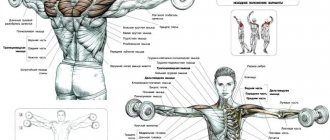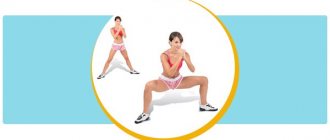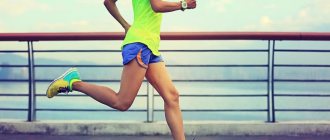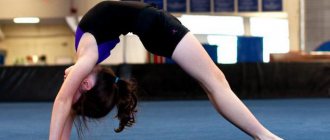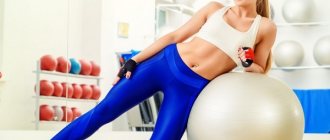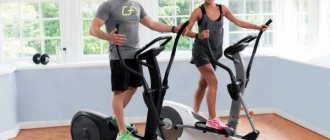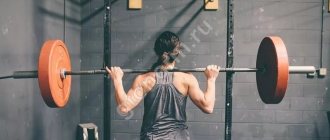Anyone who visits the gym at least occasionally has probably seen athletes with massive belts on their stomachs. Such an athlete can be seen lifting a barbell, squatting with heavy weights, doing deadlifts and other exercises. Athletic belts can be seen on both men and women. Usually they are worn by those athletes who work with heavy weights, but it happens that such a belt is also worn by a fragile girl or a thin man.
What kind of thing is this? Who needs it? What does it help with? Which one is needed? Is it possible for everyone and for what purposes? Does it only need experienced athletes or can everyone use it? Is it only needed for working with maximum weights or can it also help with less impact training? All these questions can be asked by a beginner, and not only a beginner, athlete.
In this article we will help you understand the question of what an athletic belt is, why it is needed and who needs it.
What is an athletic belt
Let's start with the fact that an athletic belt is an important accessory for any powerlifter and weightlifter. But not only security forces use this accessory. It will be useful for almost any bodybuilder. The belt is needed to maintain intra-abdominal pressure. It allows you to fix the spine vertically and avoid injuries when lifting weights. Cleans, jerks, squats, deadlifts and presses - all of these exercises are considered traumatic. Especially if performed with maximum weights. After all, all this is a compression load on the spine and, of course, it cannot be useful.
Abdominal muscles tense equally
Overall, there was a 25-40% increase in intra-abdominal pressure during squats, but no decrease in external oblique tension was noted during belt squats.
At the same time, adherents of squats without a belt claim that such squats better load muscles such as the external oblique, internal oblique, rectus abdominis, and the transversus abdominis muscle. The reason for this statement, apparently, is that the listed muscles seem to have to tense more strongly to create such intra-abdominal pressure without a belt. However, the study does not support this argument.
How does an athletic belt work?
Each person has his own natural belt, which, roughly speaking, holds the spine and regulates intra-abdominal pressure. These are stabilizer muscles. It is with the help of these muscles that our body resists compression loads, that is, compression of the spine. This natural belt can handle quite large loads, especially if you train it. But there are loads too serious for our body to cope with on its own.
And usually these are heavy weights in basic exercises.
Everyone knows that without basic exercises there is no bodybuilding, and this is where an athletic belt can become an indispensable assistant for an athlete. By helping to maintain intra-abdominal pressure, it helps the core remain more stable and allows the spine to take more stress without serious consequences.
Study “Effectiveness of using a belt for squats”
Let’s refer to the study “The Effectiveness of Using a Belt for Squats.”
For the study, experienced athletes were selected who could squat either with at least 1.6 of their body weight (i.e., with their own weight of 100 kg they could squat with at least a barbell of 160 kg), or with a barbell of at least 125.5 kg, at least for 8 reps.
However, during the study itself, many aspects of squats were measured: muscle activation, angles of inclination (to control for changes in technique), intra-abdominal pressure, exercise time.
In the study, athletes squatted their pre-measured 8-rep max without a belt. With this weight, the subjects first did squats with a belt and then without it.
And here are the results the scientists got.
Types of athletic belts and how to choose yours
There are two types of belts.
1. Weightlifting belt. It is wider at the back and narrower at the front. It is considered universal and is suitable for both weightlifters and bodybuilders. May be more or less massive. When trying on, be sure to pay attention to whether the belt fits well to the body.
2. Powerlifting belt. This belt is the same width along the entire length, usually 10 centimeters. Provides fixation for the abdomen and is suitable only for powerlifters.
All belts are usually made of leather and leather substitute. There are also models made of fabric. When choosing a belt, you, of course, need to try it on. It should not be too long, not too short and fit snugly to the body on all sides.
Weightlifting Equipment
The tights are suitable for training sessions and competitions. The lightweight cut allows the athlete to move freely. The equipment does not restrict the athlete’s movements.
Weightlifting overalls are selected individually for each athlete. Children's models differ in available sizes. Men's overalls differ from women's in design.
The fabric should tightly wrap around the hips, pelvis, and back to reduce the risk of ligament injury. Additionally, you can use elastic bandages in the groin area and lower back.
For those competing in competitions, tights with reinforced double seams and additional piping along the edge of the leg are suitable. For sensitive skin, cotton models are available, to which a small percentage of synthetic fabric is added to increase elasticity.
Weightlifters
Weightlifting shoes got their name from weightlifters who, while lifting weights, wore special shoes that helped improve balance.
Characteristics:
- Treads on anti-slip soles guarantee maximum grip on the floor.
- A 1.5-2 cm heel is an additional support that prevents falls.
- Orthopedic pad – prevention of flat feet.
- A raised heel protects against ligament damage.
- Lacing, special straps with Velcro - maximum ankle fixation.
When choosing men's weightlifting shoes, you need to take into account the material from which the sports shoes are made. Natural leather is considered the best solution; artificial leather is considered an equally practical option. It is important that the seams are strong. The sole is hard, the weightlifting sneakers are stable. You can check by putting them on and doing squats. If there is discomfort during the exercise, or deformation of the sole is observed, the model will increase the risk of injury.
The weight bar must be laced, straps, Velcro and other mechanisms must clearly secure the foot. Boots must be chosen according to size. These shoes for weightlifting are intended for performances and for visiting the gym. Boots from world brands differ in design, material and construction, and a high price. Budget manufacturers produce universal models, the characteristics of which are similar to high-end boots. The key differences are designs, appearance and material.
Athletic belt
Any athlete knows what elements of equipment are necessary to perform the exercise well.
A weightlifting belt is an attribute for effective exercise, providing reliable fixation of the spine. A weightlifting belt will reduce the occurrence of injuries during strength exercises. During the entire exercise, the spine takes on almost the entire load; the athlete’s task is to protect it.
Weightlifting belts are divided into several types depending on the material used in production. There are natural (buffalo) models that have a wide range of advantages:
- service life;
- maximum vertebral support;
- comfortable anatomical shape that adapts to the athlete’s physique;
- double stitching to reduce the risk of tearing.
Models made of artificial material are made of neoprene. The belt is elastic and reliable to wear. Special tabs are additionally created on the inside to provide rigid support for the ribs. These models use Velcro as a fastener, making it easier to put on the belt.
According to the method of use, the belt is divided into models:
- With adjustable width. Used in bodybuilding when performing exercises with a straight body. It is better to choose options with an expanded area in the back.
- No adjustment, suitable for powerlifting. The width is identical on all sides.
Women's and men's belts are recommended to be worn:
- when lifting heavy loads;
- after injury;
- at the initial stage of classes.
It is not recommended to wear a belt throughout the entire training process.
Belt carabiner
To secure the belt, you can use one of three existing fastener options:
- classical;
- bracket;
- carbine.
The first one is known to everyone who wears standard trouser belts.
As for the remaining two, they are considered more original. The bracket is a reliable and lightweight design that provides strong fixation. A sports belt with a carabiner is suitable for those who customize the design for themselves once, that is, purchase equipment personally for their activities. You know what you need to do weightlifting. Remember that not only the effectiveness of training, but also your health depends on the quality of equipment.
Training with an athletic belt
We have already found out that a belt is needed when an athlete lifts maximum weight.
Do I need a belt if the athlete is not training at maximum? There is no clear answer to this question. But still, experienced athletes do not recommend beginner athletes wear belts. Since each of us has our own natural protective belt, it needs to be trained. If you increase your loads wisely and gradually, then your muscles will adapt to them naturally. But even with an athletic belt, you should never begin maximum training if you don’t have your own strong muscle corset.
If the belt is already in use and used correctly, then there are, in general, only two rules:
- remove the belt between approaches;
- Don’t get carried away with using it and alternate training with and without a belt.
What is a weightlifting belt?
The weightlifting belt, which can be purchased in our online store, has become quite widespread due to its properties. It resembles a regular belt, which is made several times larger and wider. It is used by ordinary people for weight training, as well as by bodybuilders. It is believed that the trend for such devices came from ancient times, when wrestling at the Olympic Games was just beginning, but confirmation of this has not yet been found in literary sources.
When a belt is absolutely necessary
From all of the above, it is clear that a belt is needed in basic exercises performed with maximum weights.
It is also necessary for health problems. For example, with back injuries.
But we once again emphasize that it is very important to correctly assess the balance of risks and benefits. Often, with an injured, sore back, it is better to completely abandon heavy training for some time. It is also necessary to remember that in squats and deadlifts, the belt has virtually no effect on the tension of the abdominal muscles. That is, you need to strengthen your core muscles yourself without a belt with the help of special, well-known exercises.
A factor of psychological positive influence when wearing a belt was noted. Simply put, an athlete may find it easier to get past a sticking point because they feel more confident in the belt.
How to wear it correctly
The belt must not only be chosen correctly in the store, but also put on correctly before training. It is recommended to first apply it to the back and only then adjust the clasp on the front. It should be tightened tightly, pressing it as hard as possible against the pelvic bones.
It is important to remember that the belt is only used during training or performing exercises. It will need to be removed when you take breaks between sets.
Properly selected equipment, as experienced athletes say, is more than half the success of training. Victory in competitions depends on high-quality and correctly selected sports equipment.
Can a belt weaken your core muscles?
There are no large-scale studies on this topic. But it is quite logical to assume that constantly wearing an athletic belt can reduce the tone of the supporting muscles. They simply get used to being held constantly and stop working to the fullest extent necessary. With this in mind, experienced athletes never wear a belt all the time. Don't forget to alternate your workouts and strengthen your core muscles with traditional exercises, such as crunches, planks, various leg raises, and so on. With moderate wearing and a competent approach, an athletic belt will be an excellent assistant in achieving results.
